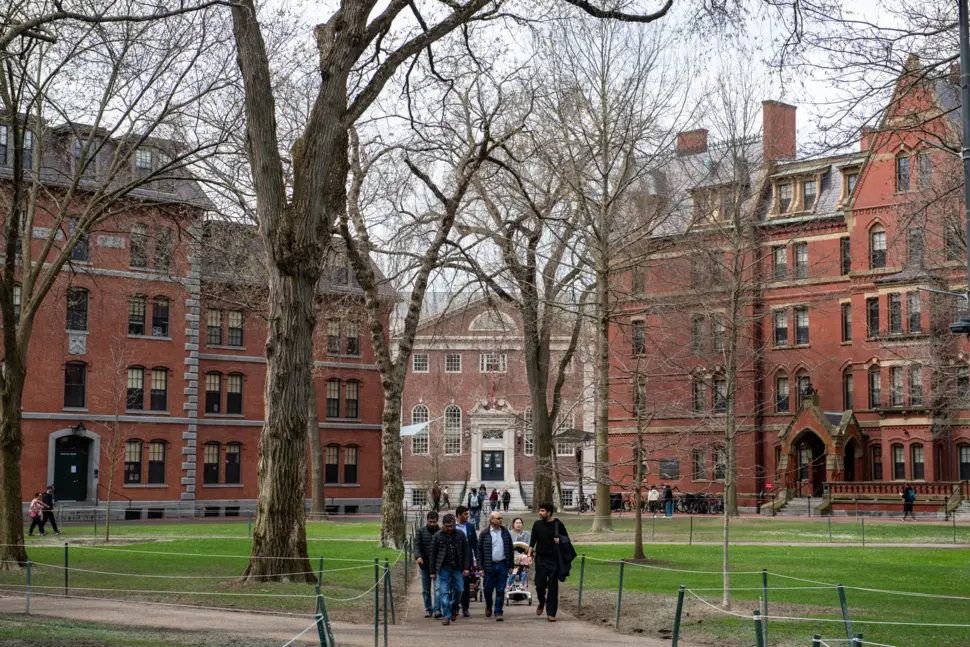Listeners:
Top listeners:
-
 play_arrow
play_arrow
The Breeze Radio The Breeze Radio
Universities say congressionally approved cuts to SNAP will worsen food insecurity and impact graduation and enrollment rates.
Activists and a growing number of lawmakers are raising concerns over the potential consequences of recently approved cuts to the Supplemental Nutrition Assistance Program on a segment of the population not always associated with food insecurity: university students.
SNAP — formerly known as food stamps — is the country’s largest federal nutrition assistance program, serving about 41.5 million people and 22.3 million households as of 2024. A significant portion of recipients are adults ages 18-59. Roughly 600,000 college students actively relied on the program as of 2020.
Provisions included in the reconciliation bill passed by Congress slashed nearly $186 billion in funding from 2025 to 2034 by shifting more of its costs to state governments and adding new work requirements to fund the sweeping federal spending package informally called the “big, beautiful bill.”
College students, as one 2023 study on the subject said, “have often been considered to be of a ‘privileged’ or ‘elite’ group” – a factor likely contributing to their finding themselves in the crosshairs of government cost-cutters claiming they are stamping out waste, fraud and abuse in the system. Yet advocates argue the changes will leave millions at risk, particularly college students who already struggle with access to reliable, affordable meals. They also say that proposed cuts would deepen disparities in higher education, making it harder for students from low-income backgrounds to stay enrolled and complete their degrees.
“Students will have to make difficult decisions on how to acquire enough food to eat, taking away time, energy, and resources they would otherwise be contributing to their education, and they are likely to go undernourished in ways that also will likely affect their academic performance,” says Jessica Thompson, the senior vice president of The Institute for College Access and Success.
Hunger on Campus and SNAP
Food insecurity has been a prevalent issue on college campuses for years. But rising costs of education, limited income for students and gaps in assistance programs have made the problem worse in recent years.
The Hope Center for College, Community and Justice reported in 2023 that roughly 1 in 3 college students experienced food insecurity. Data suggests that students from low-income backgrounds, student parents and first-generation students of color, among others, are disproportionately impacted by the problem.
Colleges and universities have moved to support students with food pantries, swipe donation programs, emergency aid grants and subsidized campus dining.
Chad Saylor, a spokesperson for James Madison University, says that the school has been assisting its students in other ways, including the Student Support Hub that gives information on food assistance and campus resources.
“JMU also provides student resources such as AmeriCorps Vista, an individual who works directly with students in understanding the SNAP program, as well as the SNAP Advocate Network, which is comprised of JMU faculty and staff members available to support our students,” says Saylor.
Thompson notes that while these resources are critical, they are “nowhere near the scope and scale of the federal SNAP program.”
SNAP remains the largest assistance program for students. The Agriculture Department’s Food and Nutrition Service says that, while most SNAP eligibility rules apply to all households, there are unique requirements placed on students.
Still, the number of students who qualify versus those who use the benefits is vastly different. Mark Huelsman, director of policy and advocacy at The Hope Center for Student Basic Needs at Temple University, says the main reason for the discrepancy is the additional “complex and very difficult to navigate” rules the program places almost exclusively on students.
“If you’re a full-time student or enrolled at least half-time in school, you are required to not only meet the regular SNAP eligibility criteria but also meet an additional exemption from a list of very complicated exemptions to be eligible,” he says.
Students attending a higher education institution at least part-time must meet the general income eligibility requirements for the program and fall under an exemption like working at least 20 hours a week or participating in a federal or state work study program. Student restrictions do not apply to those attending school less than part-time and receiving the majority of their food through a mandatory or optional meal plan are ineligible.
Celeste Davis, a health studies professor at American University’s College of Arts and Sciences, adds that traditional students aren’t always aware of the benefits they qualify for versus what they may be transitioning off of from their parents.
Cuts to SNAP in the ‘Big, Beautiful Bill’
Congressional Republicans approved cuts largely to social safety net programs like SNAP and Medicaid to offset the high price tag attached to making President Donald Trump’s 2017 tax cuts permanent. SNAP, in particular, found itself under the microscope as the federal government has long shouldered the primary fiscal responsibility.
The new plan spells out several major changes, including requiring recipients to work or participate in qualifying programs for at least 80 hours a month. It also expands the age range of those required to work from 18-54 to 18-64.
Another big change is a shift in payment that forces states to foot 75% of the bill instead of 50%.
States with an error rate above 6% in their eligibility payment determinations now must contribute up to 15% of benefit amounts. States with error rates below that threshold are also required to pay a minimum of 5%, with Alaska and Hawaii receiving temporary exemptions.
The Congressional Budget Office, a nonpartisan scorekeeper, estimates the work requirement expansion will save around $69 billion and the cost-sharing revision will save between $25 to $40 billion. But the savings come at a steep cost as the office estimates that over 3 million people will lose some or all support each month as a result.
Universities and Congress Warn Conditions Will Worsen Under New Cuts
Experts and lawmakers now warn that food insecurity among students will worsen, saying the new work requirements will disproportionately impact vulnerable student groups and the shift in payment will disincentivize states to push for student sign-ups. The result, they say, will be rising food insecurity on campuses and a decline over time in enrollment and graduation rates.
“It’s clear that this Big Ugly Bill in Washington prioritizes tax cuts for billionaires over kids, working families, and students who rely on programs like SNAP to afford groceries and remain healthy to go to work and school,” Democratic Sen. Raphael Warnock of Georgia tells U.S. News.
Valerie Imbruce, the director of the Center for Environment and Society at Washington College, adds that the work requirements will particularly impact more part-time, non-traditional college students from being eligible.
“It’s easy to characterize the typical college student as an 18- to 24-year-old still dependent on their parents, and the original restrictions were meant to curb abuse of college students from wealthy families receiving SNAP. But today, almost three-quarters of all college students in the U.S. are non-traditional college students, over 24 years old – those with dependents, doing later-in-life career changes, veterans, refugees and asylum-seekers – who are going to school part time to better themselves and be able to earn more than a minimum wage,” she says.
Davis says the shift in costs is also expected to cause headaches because states cannot cover it, noting that’s why the partnerships for SNAP and Medicaid exist in the first place. She says the staggering price tag will lead to cuts, decreased access for those who already use it and a sharp decline in enrollment.
“You’ll not only see people not accessing SNAP, you’ll see a roll off of people who are accessing higher education because they are trying to just get basic needs met on top of trying to do rigorous academic work,” Davis says.
Huelsman says both changes will likely leave a deep impact on states’ higher education budgets.
“It will either increase tuition and fees and costs to students directly, which increases the likelihood of food insecurity, or it’s going to mean cuts to student services and other support services that students need to rely on on campus, whether that’s food pantries, basic needs centers, other services that require public appropriations to help run.”
Huelsman notes that the gap left over will be very hard for colleges to fill, especially at community colleges and institutions that enroll high numbers of food-insecure students. He hopes that schools will still prioritize the services but notes that it becomes a math problem at some point.
He says the result is low enrollment, retention and graduation rates, calling it an “anti-college completion strategy.”
“The fact is that we can’t expect students to persist through their degree program and eventually complete it if they cannot meet basic essentials such as food or housing or childcare. The fewer resources we’re putting into that, the more we jeopardize the ability of the most marginalized students to complete their degree program.”
Written by: Joshua Stuart
Similar posts
Recent Posts
- Halloween-Themed Witches Day Out Set For This October In Port Jefferson
- 4 People Broke Fence, Went Inside LA Fitness In Centereach: Police
- You Can Keep Your Shoes on at TSA Airport Security Now — But Here’s What Still Has to Come Off
- Mastic Man Fired Several Rounds Into Air In Child’s Presence On July 4: Police
- The Art of the Retreat: Trump Delays Tariffs Again
Recent Comments
No comments to show.Chart
-
-
 play_arrow
play_arrow
You Are (Single Edit) Lionel Richie
-
-
-
 play_arrow
play_arrow
Da Ya Think I'm Sexy? (2008 Remaster) Rod Stewart
-
-
-
 play_arrow
play_arrow
I Just Called to Say I Love You (Single Version) Stevie Wonder
-
-
Top popular

You Can Keep Your Shoes on at TSA Airport Security Now — But Here’s What Still Has to Come Off

Long Island Man Experiences Medical Event, SUV Crashes Into Tree And Catches Fire: Police

Universities, Students Brace for SNAP Cuts

NY Lottery Winning Take 5 Ticket Sold In Suffolk County

Suffolk To Spray Davis Park’s Ground For Mosquitoes
Get in Tune with Us!
Reach out to us for inquiries, requests, or collaborations, and let’s keep the music alive.
Licensed By

© 2025 Stuart Broadcasting Studios. All rights reserved.







